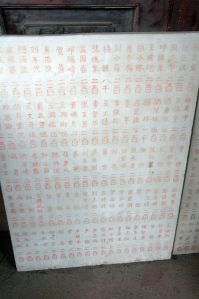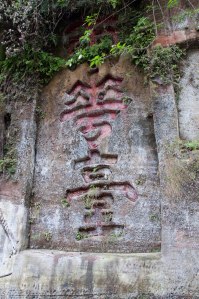This sign was carefully posted beside a path on Le Shan. I can read every English word, but without the Chinese, I would have no idea what it means. The Chinese sentence starts politely with “qing,” or “please.” I see the character for “xia,” which means “below.” Based on these two characters and the context, my guess would be that the sign is asking us not to throw things down the side of the mountain. What’s your guess?
Reading 5: Reading Between the Lines
21 Jul 2014 1 Comment
in characters, Chengdu, Parks, Reading the Environment, Translation Mistakes Tags: parabolic, signs, translation mistakes
Reading 4: A Sentence I Can Read!
20 Jul 2014 Leave a comment
in characters, Chengdu Tags: Chinese characters, reading
It is so rare for me to find even one sentence that I can read on my own, so I was thrilled to be able to conquer this one at the phone company. (Qing C0219 dao 09 chuang kou, or Number C0219, please go to service window 09.)
Reading 3: Snow White
19 Jul 2014 Leave a comment
in characters, Chengdu, Children Tags: reading, Snow White
Each day in class, we read one page of this storybook, with painstaking slowness. Already knowing the story doesn’t help as much as I expected.
Reading 2: My Teacher’s Comics 2
18 Jul 2014 Leave a comment
in characters, Chengdu Tags: Comic, grammar, teacher
Reading 1: My Teacher’s Comic 1
17 Jul 2014 Leave a comment
in characters, Chengdu Tags: Comic, reading, teacher
To help me learn to read, my creative and dedicated teacher drew a comic! (Bu hao hao xue _____, wo jiu chu lai gen ni _____, or If you don’t study well, I won’t go out with you.) I guess a cute drawing can sometimes hide a threat. (Unfortunately I have already forgotten the meaning of two of the characters.)
Qingcheng Mountain 14: Translators
12 Jul 2014 Leave a comment
in characters, Chengdu, English, Mandarin Tags: Qingcheng Mountain, students, Translation
These students, who are studying English at a university in Chengdu, overheard me reading characters from the tablet. They helpfully explained to me that it is a list of people who have donated money to the Cloud Mountain Temple, along with the amounts of money they donated. Sometimes if feels like every person is committed to helping me learn Chinese! I am so thankful for the help, so graciously offered.
Qingcheng Mountain 13: Donations Tablet
11 Jul 2014 Leave a comment
in characters, Chengdu, Faith Tags: Chinese characters, donations, reading, tablet
I found many more words I could read on this tablets than the last time I was here. There are numbers (one, two, three, eight, a hundred, a thousand) and there are words like king (wang, 王) and big (da, 大). On my own, I couldn’t make sense of it all, though.
Ancient Characters
10 Jun 2014 Leave a comment
in Calligraphy, characters, Chengdu Tags: Chinese characters
I am learning to read simplified characters, the ones that are mainly used now. There are also ancient characters that most people, even my teacher, can’t read. All characters, ancient and modern, seem to be regarded as beautiful enough to be used as decorations.
The First Sentences I Read on my Own
09 Jun 2014 Leave a comment
in characters, Chengdu, transportation Tags: Chinese characters, reading, subway
I have been studying Chinese since May of 2013. Since January of 2014, I have increased my study of reading. Although I can read hundreds of individual characters, I often have trouble finding sentences in my environment that I can read completely. Sometimes even when I can read every character in a sentence, I don’t understand what it means. This photograph shows the first two sentences I was able to read on my own. They are written on the floor in every subway station in Chengdu. The one on the right (Xian xia, hou shang) means, “First get off, then get on.” It advising people to let those on the train get off, before getting on. The one on the left (Pai dui hou che) means, “Line up to board train.”
Artist 2: Anneliese Tries Calligraphy
26 May 2014 Leave a comment
in Calligraphy, characters, Chengdu Tags: artist, Calligraphy, practice
One of the calligraphers, named J. C., offered us the opportunity to practice using his brushes. My niece and I chose the simplest characters and found writing them to be extremely challenging. After this, J. C. kindly explained that the simplest characters are actually the most difficult. The simplest character, the number one (yi, 一), he mentioned, is supposed to look like a bone, with a bit of thickening at each end.











Recent Comments